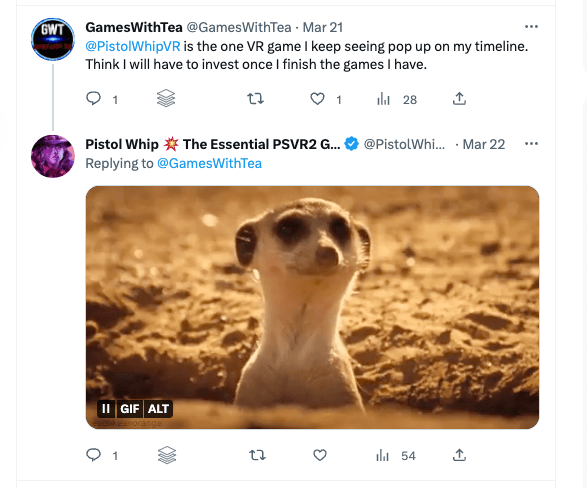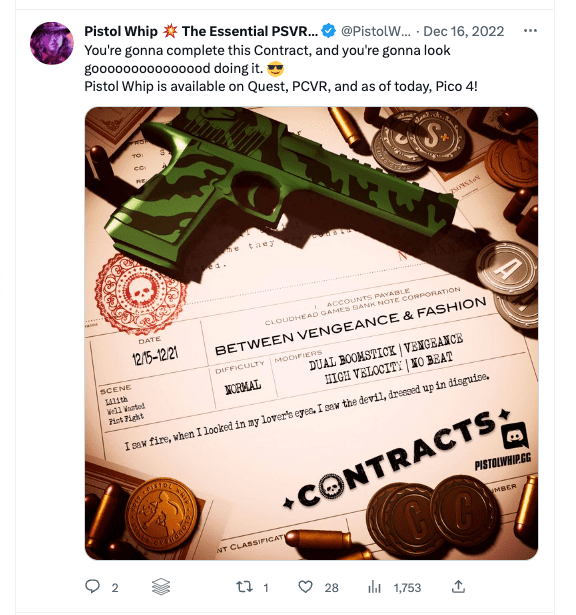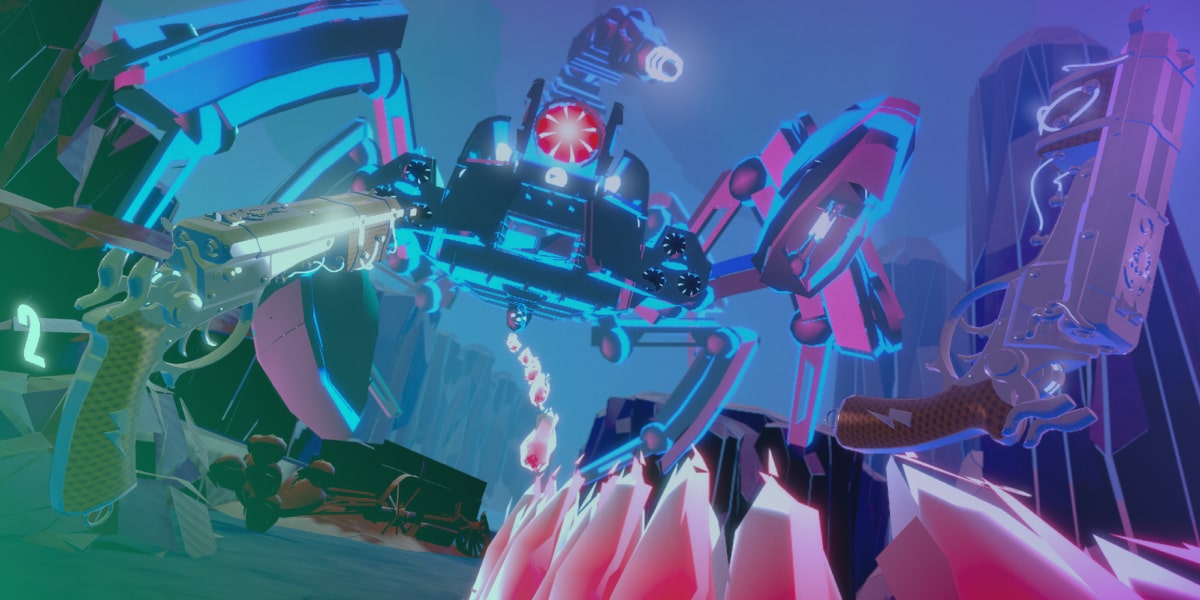According to Statista, the VR and AR markets are steadily growing. In the next five years, almost a third of people will have a headset of some description, and there’ll be about 2.5 billion players. The average revenue per user? Likely around $14. Far higher than the $0.13 that hyper-casual games get.
But making a VR game? Well, the process isn’t all that different. It’s a lucrative opportunity for developers. So we asked Ed Lago, executive producer at Cloudhead Games, for his advice on entering the market.
Who are Cloudhead Games?
Though they were founded back in 2013, their founder – Denny Unger – has been in the VR industry since the 90s. A self-proclaimed “VR garage hacker”, he made friends with Palmer Luckey, founder of Oculus, and managed to get his hands on some prototype hardware. Since then, Cloudhead Games has created multi-award-winning titles like Pistol Whip and The Gallery series. And collaborated with industry giants like Meta, Sony, HTC and Valve.
With that in mind, what’s been the secret to their success?
Ask if your game makes sense for VR
While there are some similarities between VR and mobile games – they should be easy to learn and have straightforward mechanics – a VR game is really all about fantasy fulfilment. The player should feel like they have become someone else in another world.
“As someone who made the jump from mobile games to VR, it’s all about understanding the technology and the best use cases for it,” Ed explained. “Not all types of games work properly in this medium because of the different types of hardware. Mobile developers will typically have an easier time making games for hardware like the Quest 2, because they’re used to making games on less powerful tech. Going from mobile, to mobile VR, to PC is easier than the other way around. Devs who have only worked with PC VR and consoles will often struggle making games run properly Quest 2 hardware.”
This is particularly true when it comes to how the player actually controls their character and interacts with the world.
“In mobile games, you need to focus on the key strengths, which include using the touch screen, swiping, tapping,” Ed added. “In VR, you need to take into consideration the comfort level of the user, the physicality of your experience, the amount of load cognition, and the immersion factor when the user puts on the headset.”
So developers need to think about how their mechanics can translate across to VR. What do they need to do to get the same result? Take an endless-runner style of game. On-screen, it’s simple enough to swipe left and right to make the turns.
But how will that work in VR? Does the user physically move? That might mean the levels need fewer turns, so the player doesn’t feel sick. Or do they swing their hands? If so, does that really feel immersive?
Learn from your mistakes
Whenever you enter a new market, you’ll have teething problems. You’ll be too ambitious or create a mechanic that’s just a little too complicated for VR. That’s fine. It’s a new space; everyone is still figuring out the best practices.
“With The Gallery series, we really wanted the player to have agency and feel like they were the hero in a movie,” Ed said. “In retrospect, these games were too advanced for VR at the time. The onus was on us to not only teach the player how to play the game, but how to use VR.”
By 2019, though, Cloudhead Games applied that lesson to Pistol Whip, their latest title. The core philosophy is the same – help the player fulfil a movie hero fantasy – but the gameplay itself is much more refined.
“How could we make something that was fun, super easy to just pick up and play, but hard to master?” Ed said. “These questions resulted in us developing Pistol Whip so the controller scheme is dead easy and uses one button or motion to do multiple things. We wanted a game with low cognitive load – the opposite of what came out of The Gallery series.”
Get to know the hardware
The main limitation and challenge of all VR games is the hardware itself. In fact, there are three types of hardware you should be aware of:
- Standalone headsets. These have a mobile chipset and can be worn anywhere in the house.
- Console headsets. These are powered through a specific console.
- PC headsets. These plug directly into someone’s computer.
It’s not simply that you need slightly different versions of your game to run on each of these, but the hardware itself can vary significantly.
“Making a product for all these types of hardware – which are so different from each other, with their own set of controllers and exclusive features – and making the game look and feel good is a big technical challenge,” Ed said. “This is especially true because the users of each one of these platforms are concerned about their platform being the best for the version of the game they’re playing.”
Know the process is the same, but harder
Once you’ve decided how to tackle the hardware and design challenges, the process itself isn’t all that different from what you’re likely already familiar with.
“Everything is pretty similar,” Ed said. “We always go through the cycle of ideation, prototyping, pitching, market research, funding, getting the greenlight, pre-production, production, etc…”
But throughout that process, you need to bear in mind that the players themselves are a different beast to mobile gaming. Mobile gaming is quite familiar to almost everyone. VR? Not so much.
“Your product can literally be someone’s first-ever VR game. And it could be their last if they have a bad experience with it,” Ed explained. “We still need to convince a lot of people that VR is legitimate and that you actually can have a good time playing it. So if there’s a bad experience, there’s a big chance this person won’t believe in the medium anymore.”
While making a VR game is harder, it’s still worth the effort. The opportunities in VR are endless, and the market is much less saturated than the mobile industry. It’s much easier to get spotted. But how do you get the word out and market your game?
We spoke with Cloudhead Games’ marketing team, Alex Blahout (digital and social media marketing) and Lindsay Sherman (marketing manager), to get their advice on the next step. Their first piece of advice? Get involved with the community. There are a lot of specific VR communities you can become a part of and learn from.
“Our players’ feedback has been invaluable and helped build the foundation of our success,” Alex pointed out. There were three main areas that they focused on:
- Discord. This is where the Pistol Whip community mainly resides.
- Social media and Reddit. Here they can have fun conversations with players.
- Store platforms and forums. This is where they talk about news, support and suggestions.

Once you’ve engaged with your community, it’s time to build hype around your game.
“To understand a game like Pistol Whip, you need to see it in motion,” Alex explained. “Teaser videos and trailers have typically been the marketing priority. As we continue into 2023, we plan on making more video content than ever, so our players can really get a sense of how much playing Pistol Whip is like being dropped into an action movie.”
In those videos, the key is to develop a narrative around what it’s like to experience the game. It’s not all about the mechanics.
“Building an advertisement for any title requires telling a story,” Alex added. “Your marketing strategy requires language and visuals that clearly communicate the value: getting fit, feeling like a movie hero, enjoying the action-rhythm, etc…”
Track data inside and outside your game
Your in-game analytics will help you spot where to improve your design, just like with a mobile game. But with VR, you need to track data from more sources.
“To gauge player satisfaction and the kind of experience they want to be immersed in, we use things like store reviews and comments,” Alex said. “For example, between May and September of last year, the engagement rate for our social posts on Facebook, Instagram and Twitter doubled. That shows we have a healthy relationship with our growing community.”
What you track is subjective. But there are some useful metrics that everyone should keep an eye on. And consider data from VR stores, social media platforms alike.
“We look at our Active User data (DAU, WAU, MAU) to see how many people keep coming back to Pistol Whip, as well as to see what time periods had the most in-game engagement,” Lindsay said. “We also track data within store platforms for general performance, demographics, User Acquisition, and Marketing Attribution.”
But know that the results might not always be what you expected.
“The key difference for VR versus any other platform is, primarily, the high adoption barrier to owning a headset, combined with the (relative) newness of VR,” Alex added. “This leads to fewer opportunities to gather important data and find relevant benchmarks.”
Keep improving your design
Those metrics can help you iterate and evolve your game. For Cloudhead Games, they were able to keep track of how players were responding to their updates and new content. Back in June 2022, they released Contracts – new ways of playing Scenes (levels) and adding in new challenges every day, week and month.

“We analyze certain in-game analytics to track progress,” Lindsay said. “How many players are participating? What are they engaging in? Which Contracts are they completing? Are they going through the more vigorous monthly Contract?”
With that information, Cloudhead Games can figure out which of these challenges are successful and where they can improve them to be more fun, comfortable and challenging.
Start your journey
If you need help with keeping track of the data in your games, our free tool has SDKs that work across all the major VR platforms. So plug in and get to developing your first prototype. Get started.





















Discussion about this post